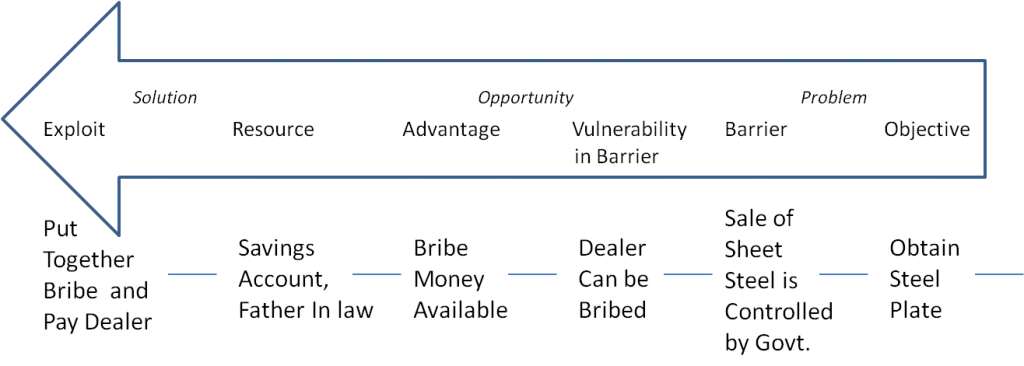FOLLOW-UP to the previous post: here are some specifics on how to devise complex strategies.
In that post we were using the example of Achim Weyer’s escape from E. Berlin. Weyer had decided to escape by armoring a car and making it through a checkpoint (gate location) in The Wall.
If we were to devise a complex strategy along the line of Weyer’s, we would go through a process of sketching two kinds of diagram. This gets the key points of our strategy down on paper, and in the process, into our heads.
The Objectives Diagram
First, we’d identify the objective(s) (in this case Escape E. Berlin) and the sub-objectives (to the left in the diagram). The result is a picture of what we really have to accomplish, and confidence that we’re well on the way to having a workable strategy. These subobjectives are working objectives and may need to be adjusted as we get a better handle on their barriers, etc. It would look something like this, right to left:
For his escape objective to succeed, he had, in turn, to succeed at many subobjectives. Weyer needed to find a checkpoint that would be manageable to get through, and he needed to construct a sufficiently armored car that would last long enough to get through it.
To find a manageable checkpoint, he in turn had to locate one that had no serious physical barriers (like impenetrable gates), minimal traffic (to get in his way), a reliable guard routine (no surprises), and minimized exposure to machine gun fire.
To construct a sufficiently armored car, it would also help to minimize the car’s exposure to machine gun fire, and he had to adequately armor the windshield, body, trunk and doors. To adequately armor the windshield, body and trunk, he had to obtain and install enough suitable steel plate, and to armor the doors, he had to obtain and pour in enough cement.
This decomposition into further sub-objectives could go on and on, so it’s important to not take it any further than necessary (life’s too short and we don’t need or want gratuitous detail).
The objectives diagram (along with the underlying strategy) is a network structure. I.e., unlike a tree structure, it can have shared elements (e.g. minimized exposure to machine gun fire). This kind of diagram would be immediately recognizable to anyone with experience in project management.
The Strategy Diagram
Once we have our objectives diagram in our pocket, we can set off to develop our sub-strategies – backwards. We start with the lowest level objectives on the left and pick, for example, “Obtain Steel Plate”. We do the usual simple strategy design drill: determine the 6 elements by establishing the problem, opportunity and solution, and lay them out in a strategy diagram. Liberal use of creative and critical thinking, as required.
Problem: We want to obtain enough steel plate for our project (objective), but the govt. has the sale of this strategic material under its control (barrier). Opportunity: during these difficult times we can find a supplier who can be bribed (vulnerability in the barrier), and money is available for this purpose (advantage). Solution: there’s enough in our savings account and from our father in law (resources), so we just have to put it together and pay off the dealer (exploit). That’s our sub-strategy for obtaining steel plate.
Now fleshing out our strategy can go quickly. What about “Obtain Cement”? No problem here. We can get it from any of several construction supply outlets. So we don’t need to describe a sub-strategy for it; we can just do it.
Once we have the sheet steel and cement, we can armor the car. We’ll do this by hand, trial and error, and there’s little need for further articulating the strategy to do this.
To continue with the strategy, we go back to the other low-level objective to “Minimize the Time in the Checkpoint Area”. There are different ways of seeing to this need (e.g. a straighter course through the checkpoint that would allow higher speed), but finding a checkpoint with its last guard house close to the wall (border) would be best because the now-heavy armored car won’t be very fast, anyway.
Here, and with the “no serious barriers”, “minimal traffic”, and “understood guard routine” subobjectives, we only have to spend time closely observing candidate checkpoints and picking the one that has the best combination of characteristics. Here again, no substrategies have to be articulated. We know what we have to do (and we choose the checkpoint at Chausserstrasse).
At this point we’ve determined what we have to do to meet both our “find manageable checkpoint” and “construct sufficiently armored car” subobjectives. And that’s it. It means we can now go out and meet our objective of escaping E. Berlin – with a bit of help from Lady Luck (not shown).
The method used here, based on the General Strategy Model, turns out to be really simple. All that’s necessary is to break out the objectives/subobjectives and then articulate only those substrategies needed to meet the more difficult subobjectives.
This is an important point. The objectives and strategy diagrams are just tools, there to serve the development of our strategy. They’re here to aid our creative thinking and critical thinking processes. No reason to over-elaborate them or over-formalize them. That just increases complexity.
____________________________________________________________________________
Readers are encouraged to add comments to this post.
And if you’d like to share or recommend the post, click on your preferred way in the left margin sidebar.
Stay tuned for the next post. I’m pretty sure it will be about scams …
If you’re not currently being automatically notified when new posts are published, then please Follow Real Strategy (top of right hand column on this page), and indicate how you’d prefer to be notified.
For other posts of interest, look in the Smart Menu.
BYB6NREXZYJG








Great example of successful strategy.
Here is a link to a talk that describes examples of unsuccessful strategies:
http://www.ted.com/talks/jared_diamond_on_why_societies_collapse.html
[Translate]